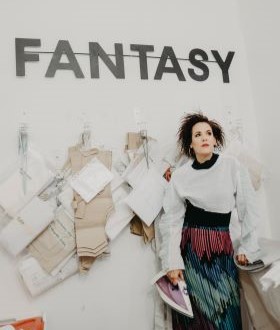Villa Serpentara Fellowship 2026

Kinga Tóth
*1983 in Sárvár (HU)
Lives in Hungary, Austria and Germany
Web: www.kingatoth.com
Instagram: @kingatothkina
Section: Visual Arts
Vita
Kinga Tóth is a linguist, visual-sound poet, illustrator and cultural manager. Tóth writes in German, Hungarian and English and presents her texts in installations and performances. She is also a founder of an organisation for equal rights and women’s representation in the literary world in Hungary. She researches art by nuns as part of her Inter-university PhD Programme (W & K), PLUS-Mozarteum, at Mozarteum University. Tóth explores the lives and creations of nuns, as well as eco-feminism, in her artistic practice.
For her intermedia/international work, she received the Hugo Ball Award and the Bernard Heidsieck Prix in 2020. In 2021, she was a guest artist at Villa Waldberta and her text-photo installations were exhibited in Tallinn; her graphic poems were showcased at the Centre Pompidou; and her intermedia installation work featured at the MODEM Gallery. In 2023, she performed her new intermedia theatre piece, Electric Jungle, with the composer and musician Silvia Rosani as part of the Hannsmann Prize at the Theater Rampe in Stuttgart.
In 2023-24, Kinga Tóth received a DAAD scholarship for literature in Berlin and was shortlisted for the Wortmeldungen Literature Prize and the Lajos Kassák Prize. In 2024, she published her vocal-lyric-singing album, accompanied by an object poetry installation in the DAAD Gallery as part of the DAAD scholarship, and was a guest artist of the MuseumsQuartier programme in Vienna. Her new book will be published by Matthes & Seitz in 2026.
Residency
Kinga Tóth works “in the spaces in-between”, be they between genres (literature, performance, visual/sound art, theatre), between languages (Hungarian-German-English), cultures (East-West identities, feminism), the living and the non-living (near-death experiences, chronic health conditions, spirituality). She likes to create “living text bodies”, to bring stories, texts to life, and this is where she invites us to join her, not only as spectators, but as co-thinkers/makers. At the Serpentara, she will deal with prayers of the new (post)apocalyptic era, old and new rites, archival materials on text-sound-visual and performative levels, and build a new exhibition (and a new art album) with texts, objects, sound works, photos, graphics and performance.